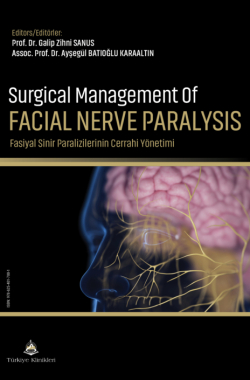Late Decompression in Acute Facial Paralysis After Temporal Bone Fracture: Is Surgery Needed?
Taner TANRIVERDİa, Galip Zihni SANUSa
aİstanbul University-Cerrahpaşa, Cerrahpaşa Faculty of Medicine, Department of Neurosurgery, İstanbul, Türkiye
Tanrıverdi T, Sanus GZ. Late Decompression in acute facial paralysis after temporal bone fracture: Is surgery needed?. In: Sanus GZ, Batıoğlu Karaaltın A, eds. Surgical Management of Facial Nerve Paralysis. 1st ed. Ankara: Türkiye Klinikleri; 2022. p.127-32.
ABSTRACT
Facial nerve is the most commonly affected nerve after temporal bone fracture following head trauma due mainly to the anatomical relationship with the temporal bone. Management of traumatic facial nerve paralysis is challenging and there has been no data that may lead surgeons to have a common consensus. Furthermore, little information is available in the current literature related to the functional outcome of late decompression and debate is still whether late decompression should be performed or not. This chapter aims to provide an insight to the young surgeons, especially neurosurgeons and ear-nose-throat surgeons, to manage this devastating clinical condition timely. Given that there are no high-level clinical studies, the importance of discussing this issue becomes clear. The current body of evidence suggests that late decompression should be performed even in the absence of visible temporal bone fracture because late decompression has still a beneficial effect on functional recovery.
Keywords: Decompression; facial paralysis
Kaynak Göster
Referanslar
- Brodie HA, Thompson TC. Management of complications from 820 temporal bone fractures. Am J otol. 1997;18(2):188-97.
- Brown S, Isaacson B, Kutz w, Barnett S, Rozen SM. Facial nervetrauma: clinical evaluation and management strategies. Plast ReconstrSurg. 2019;143(5):1498-512. [Crossref] [PubMed]
- Darrouzet V, Duclos JY, Liguoro D, Truilhe Y, De Bonfils C, Bebear JP.Management of facial paralysis resulting from temporal bone fractures: our experience in 115 cases. otolaryngol Head Neck Surg.2001;125(1):77-84. [Crossref] [PubMed]
- Lambert PR, Brackmann DE. Facial paralysis in longitudinal temporal bone fractures: a review of 26 cases. Laryngoscope. 1984;94(8):1022- 6. [Crossref] [PubMed]
- Rajati M, Pezeshki Rad M, Irani S, Khorsandi MT, Motasaddi Zarandy M. Accuracy of high-resolution computed tomography in locating facial nerve injury sites in temporal bone trauma. Eur Arch otorhinolaryngol. 2014;271(8):2185-9. [Crossref] [PubMed]
- Fisch U. Management of intratemporal facial nerve injuries. J Laryngol otol. 1980;94(1):129-34. [Crossref] [PubMed]
- Hato N, Nota J, Hakuba N, Gyo K, Yanagihara N. Facial nerve decompression surgery in patients with temporal bone trauma: analysis of 66 cases. J Trauma. 2011;71(6):1789-92; discussion 1792-3. [Crossref] [PubMed]
- Kanona H, Anderson C, Lambert A, Al-Abdulwahed R, o'Byrne L, Vakharia N, et al. A large case series of temporal bone fractures at a UK major trauma centre with an evidence-based management protocol. J Laryngol otol. 2020;134(3):205-12. [Crossref] [PubMed]
- Quaranta A, Campobasso G, Piazza F, Quaranta N, Salonna I. Facial nerve paralysis in temporal bone fractures: outcomes after late decompression surgery. Acta otolaryngol. 2001;121(5):652-5. [Crossref] [PubMed]
- Ulug T, Arif Ulubil S. Management of facial paralysis in temporal bone fractures: a prospective study analyzing 11 operated fractures. Am J otolaryngol. 2005;26(4):230-8. [Crossref] [PubMed]
- Sanuş GZ, Tanriöver N, Tanriverdi T, Uzan M, Akar Z. Late decompression in patients with acute facial nerve paralysis after temporal bone fracture. Turk Neurosurg. 2007;17(1):7-12.
- Xu P, Jin A, Dai B, Li R, Li Y. Surgical timing for facial paralysis after temporal bone trauma. Am J otolaryngol. 2017;38(3):269-71. [Crossref] [PubMed]
- Kim J, Kim J, Park S, Lee wS. Use of computed tomography to predict the possibility of exposure of the first genu of the facial nerve via the transmastoid approach. otol Neurotol. 2011;32(7):1180-4. [Crossref] [PubMed]
- Mannarelli G, Griffin GR, Kileny P, Edwards B. Electrophysiologicalmeasures in facial paresis and paralysis. oper Tech otolaryngol Head Neck Surg. 2012;23(4):236-47. [Crossref]
- Fisch U. Prognostic value of electrical tests in acute facial paralysis. AmJ otol. 1984;5(6):494-8.
- Fisch U, Esslen E. Total intratemporal exposure of the facial nerve.Pathologic findings in Bell's palsy. Arch otolaryngol. 1972;95(4):335-41. [Crossref] [PubMed]
- Sanus GZ, Tanriverdi T, Tanriover N, Ulu Mo, Uzan M. Hearing preserved traumatic delayed facial nerve paralysis without temporal bonefracture: neurosurgical perspective and experience in the managementof 25 cases. Surg Neurol. 2009;71(3):304-10, discussion 310. [Crossref] [PubMed]
- Gantz BJ, Rubinstein JT, Gidley P, woodworth GG. Surgical management of Bell's palsy. Laryngoscope. 1999;109(8):1177-88. [Crossref] [PubMed]
- Aslan H, Songu M, Eren E, Başoğlu MS, Özkul Y, Ateş D, et al. Resultsof decompression with middle cranial fossa approach or traumatic intratemporal fascial nerve injury. J Craniofac Surg. 2014;25(4):1305-8. [Crossref] [PubMed]
- Chang CY, Cass SP. Management of facial nerve injury due to temporalbone trauma. Am J otol. 1999;20(1):96-114.
- Yetiser S. Total facial nerve decompression for severe traumatic facialnerve paralysis: a review of 10 cases. Int J otolaryngol.2012;2012:607359. [Crossref] [PubMed] [PMC]
- Ashram YA, Badr-El-Dine MM. Surgery for traumatic facial nerve paralysis: does intraoperative monitoring have a role? Eur Arch otorhinolaryngol. 2014;271(9):2365-74. [Crossref] [PubMed]

